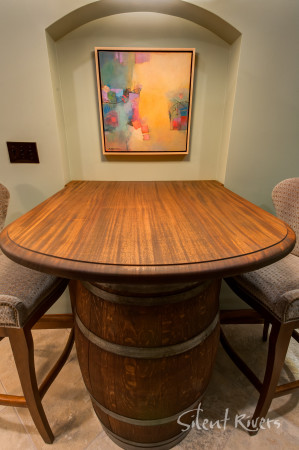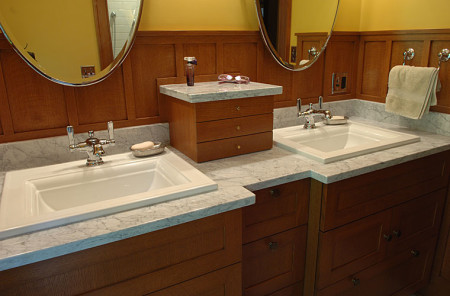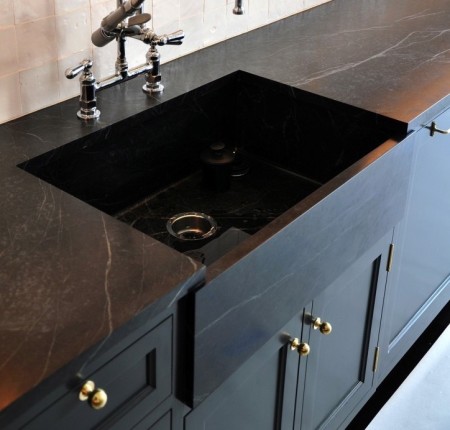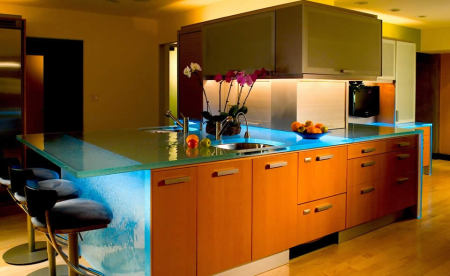Finding the right countertop material for your kitchen or bathroom can be a daunting task. There is a plethora of choices that range from the traditional granite, to the less common paper composites or glass. Here is some information about the more popular options to help get you started with your selection.
Laminate
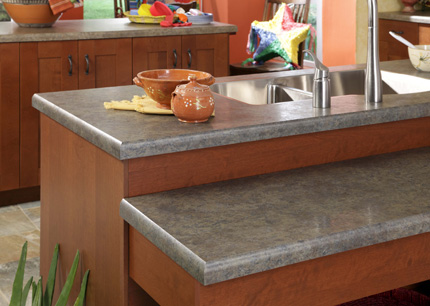
Photo courtesy of Wilsonart
Advantages – Affordability. It is one of the least expensive options with a wide range of colors and patterns available. Laminate is also a low maintenance material, with new edge treatments that make it less perceivable as laminate. New installation techniques also allow for under-mounted sinks.
Disadvantages – It can scratch and burn, and will wear in areas that see repeated contact. Moisture can cause the edge to peel.
How much does it cost? – Installed prices will start around $15 per square foot, and go up from there.
Tile
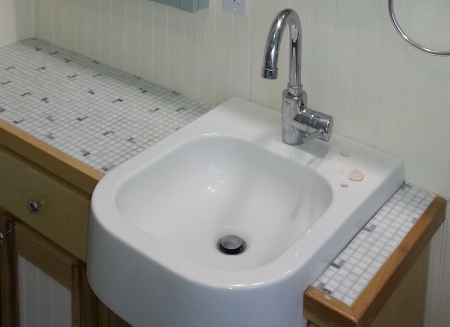
Tile countertops can come in all shapes and sizes
Advantages – Wide range of sizes, colors, and patterns. Tile is a hard surface that will resist scratches and heat.
Disadvantages – Grout joints can stain or hold grime. The irregularity of the surface can make it difficult to place something flat on it.
How much does it cost? – Installed prices will start around $20 per square foot, and go up from there.
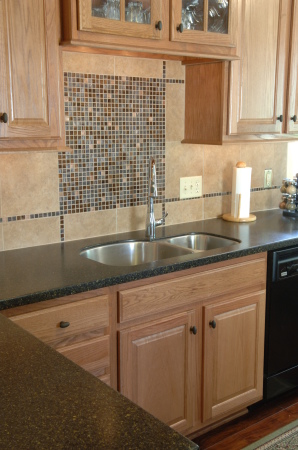
Solid surface countertops have come a long way since their introduction in same color pallet as light switches.
Solid Surface
What is it? – Made from sheets of acrylic and polyester. Commonly referred to as “Corian” which is actually a brand name.
Advantages – Solid surface is non-porous which means very low maintenance. Seams are virtually invisible and in many cases the surface can be repaired if it is slightly damaged. There are also a multitude of colors available.
Disadvantages – It scratches fairly easily, and is not resistant to heat. Historically, its appearance has been more “lifeless”, but this is changing as many manufacturers have options that resemble engineered stones.
How much does it cost? – Installed prices will start around $30 per square foot, and go up from there.
Granite
What is it? – Not all stone countertops are the same. Granite is a very hard, granular, crystalline, igneous rock consisting mainly of quartz, mica, and feldspar. It is quarried from many parts of the world.
Advantages – Each piece of granite is unique, with many natural variations. It is a very hard material that is resistant to scratches and heat.
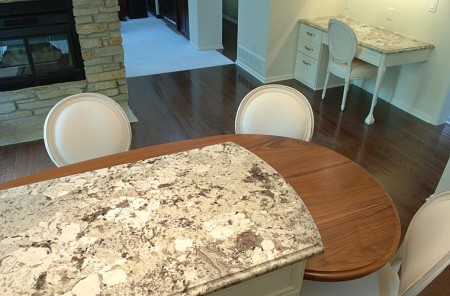
Granite countertops come is wide range of colors.
How much does it cost? – Installed prices will start around $60 per square foot, and go up from there.
Quartz
What is it? – A man-made product that mixes approximately 95 percent ground natural quartz with 5 percent polymer resins. Quartz countertops are sometimes referred to as “Engineered Stone”.
Advantages – Quartz is about as maintenance free as you can get, and a number a manufacturers offer an antimicrobial finish from the factory. It is heat and scratch resistant and comes is a large range of colors with natural looking or man-made appearances.
Disadvantages – Some of the colors can be more man-made looking and a little benign. Quartz is heavy, just like granite.
How much does it cost? – Installed prices will start around $75 per square foot, and go up from there.
Butcher Block
What is it? – Natural strips of hardwood glued together to create a work surface. Different faces of the sawn wood will provide a different levels of durability to the surface. Different finishes are available depending on how you plan to use the top.
Advantages – Wood will provide a “warm” natural appearance to the space. It will also wear over time creating a “patina” that can be very attractive, and minor blemishes can sometimes be repaired
Disadvantages – Wood can stain, but some people will see this as part of the “history” of the surface. Butcher Block tops also need regular maintenance. This is typically in the form of cleaning with a light detergent and re-sealing with mineral oil on a weekly basis. Without the upkeep the wood can harbor bacteria.
How much does it cost? – Installed prices will start around $80 per square foot, and go up from there.
Metal
What is it? – Again, could be a range of materials (e.g. Stainless Steel, Zinc, Copper, Pewter) but all are custom formed to meet the design needs of the space.
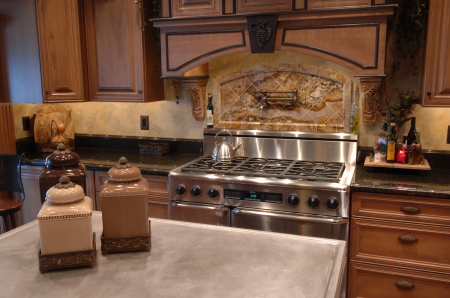
Pewter can be formed to match more intricate mouldings in the space and will form a beautiful patina throughout its lifetime..
Disadvantages – Metal countertops will tend to scratch and show fingerprints, so keeping them pristine can be a challenge. They can also be stained and etched with different chemicals, e.g. citrus juices, etc. And, depending on their construction, they can also be “loud” as they are worked on.
How much does it cost? – Installed prices will start around $80 per square foot, and go up from there.
Marble
What is it? – Marble is a hard crystalline metamorphic form of limestone, typically white with mottling or streaks of color. It is typically seen in traditional spaces or very contemporary environments.
Advantages – Marble has a very elegant appearance and is heat resistant. It also stays cool to the touch, making it ideal for working with pastry.Disadvantages – Marble is a relatively porous stone so it can stain easily. It is also relatively soft so it can scratch and chip, and its polish can be chemically etched.
How much does it cost? – Installed prices will start around $85 per square foot, and go up from there.
Concrete
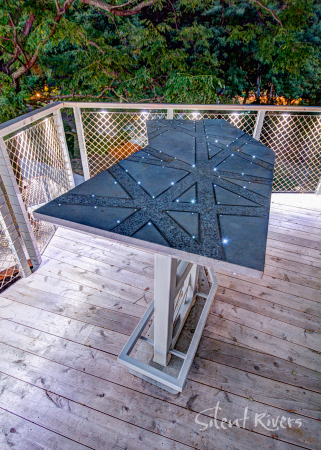
You can do many interesting things with concrete countertops. This top has multiple aggregates, stainless steel rod inlays, and fiberoptic lights
What is it? – a heavy material made from a mixture of aggregate,
cement, and water, that can be spread or poured into molds and that forms a stone-like mass on hardening.
Advantages – Concrete can be formed into any shape, including sink bowls, so your top can be completely integrated. There are many colors available and the aggregate can be virtually material as long as it in under a certain diameter. Concrete is also heat and scratch resistant.
Disadvantages – It needs to be resealed similarly to granite, and there are different sealers available depending on its use. Concrete is also heavy and can develop small cracks over time.
How much does it cost? – Installed prices will start around $90 per square foot, and go up from there.
Soapstone
What is it? – Soapstone is a soft rock consisting largely of talc, usually darker in color. Think of soapstone like marble, without the elegance. It would be right at home in a cottage-style kitchen.
Advantages – Soapstone is typically unpolished so it has a softer appearance than other stones. It will develop a patina over time.
Disadvantages – It needs routine maintenance, meaning regular oiling with mineral oil. It can also scratch and crack over time, and as with any stone, it is heavy.
How much does it cost? – Installed prices will start around $95 per square foot, and go up from there.
Paper Composite
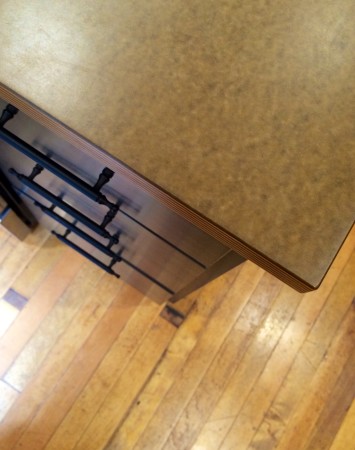
Paper composite countertops provide similar properties to solid surface while also being eco-friendly.
What is it? – Created from paper fibers mixed with resin and pressed into a solid material. It can be made with virgin fibers or recycled content.
Advantages – The properties are similar to solid surface, and it has a “warmer” feel. It is also resistant to heat and moisture.
Disadvantages – It can scratch, but minor scratches are repairable. It can stain and also requires sealing with an oil or wax depending on use.
How much does it cost? – Installed prices will start around $95 per square foot, and go up from there.
Glass
What is it? – Just like it sounds, it can be cut or formed to order, or can be used as an aggregate as a recycled material. Solid glass is typically very thick or safety glass of some form.
Advantages – Glass countertops, especially recycled glass, have similar properties to quartz countertops – heat, stain, and moisture resistant. Recycled glass also comes with a “history” as most of the aggregate was formerly bottles containing beer, wine, or alcohol. You can introduce unique lighting effects with glass countertops.
Disadvantages – Glass is heavy in any form. Solid pieces of glass can scratch and/or shatter. Glass is also relatively expensive.
How much does it cost? – Installed prices will start around $125 per square foot, and go up from there.

